Revamped forecasting in Zoho CRM
Forecasting is an important part of a business's strategy to help set meaningful targets, optimize their sales strategies to help users achieve said target and drive revenue for the business.
With this in mind, we've brought a number of different enhancements to Zoho CRM's forecasting capabilities to help businesses understand their pipeline better, make accurate forecasts, set realistic targets, and help sales teams achieve them. Earlier in December, we briefed about these enhancements in forecasts in our Winter '21 announcement. We are thrilled to talk about these changes in detail here.
Create multiple and condition based forecasts across different periods
Businesses were limited to just a single forecast that encompasses all deals, but now you can create multiple forecasts, which can include all your deals or deals that match specified conditions, with a greater control of the forecast periods.
Forecasts can be created for all the available hierarchy:
- Role/Reporting to
- Territory
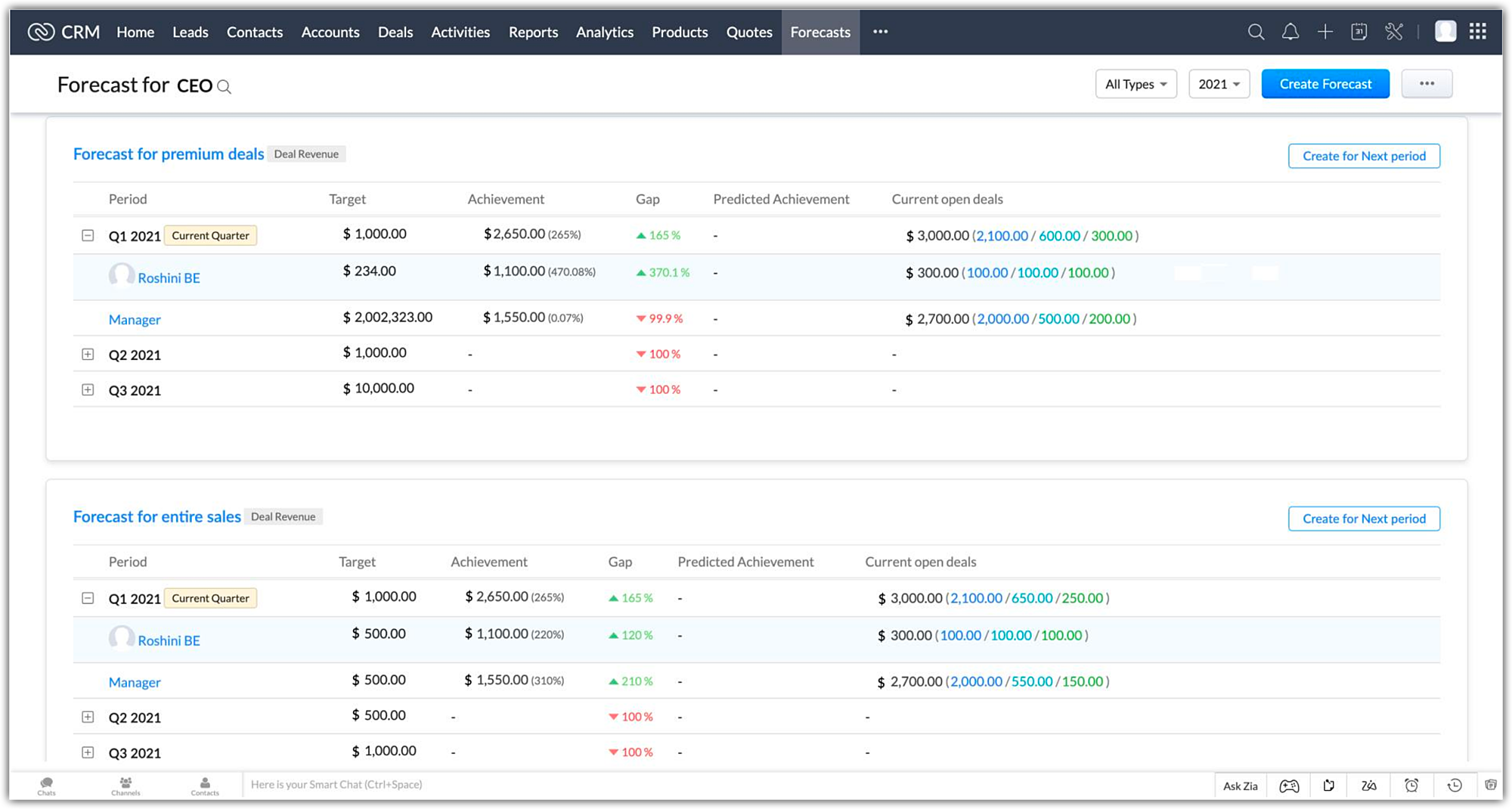
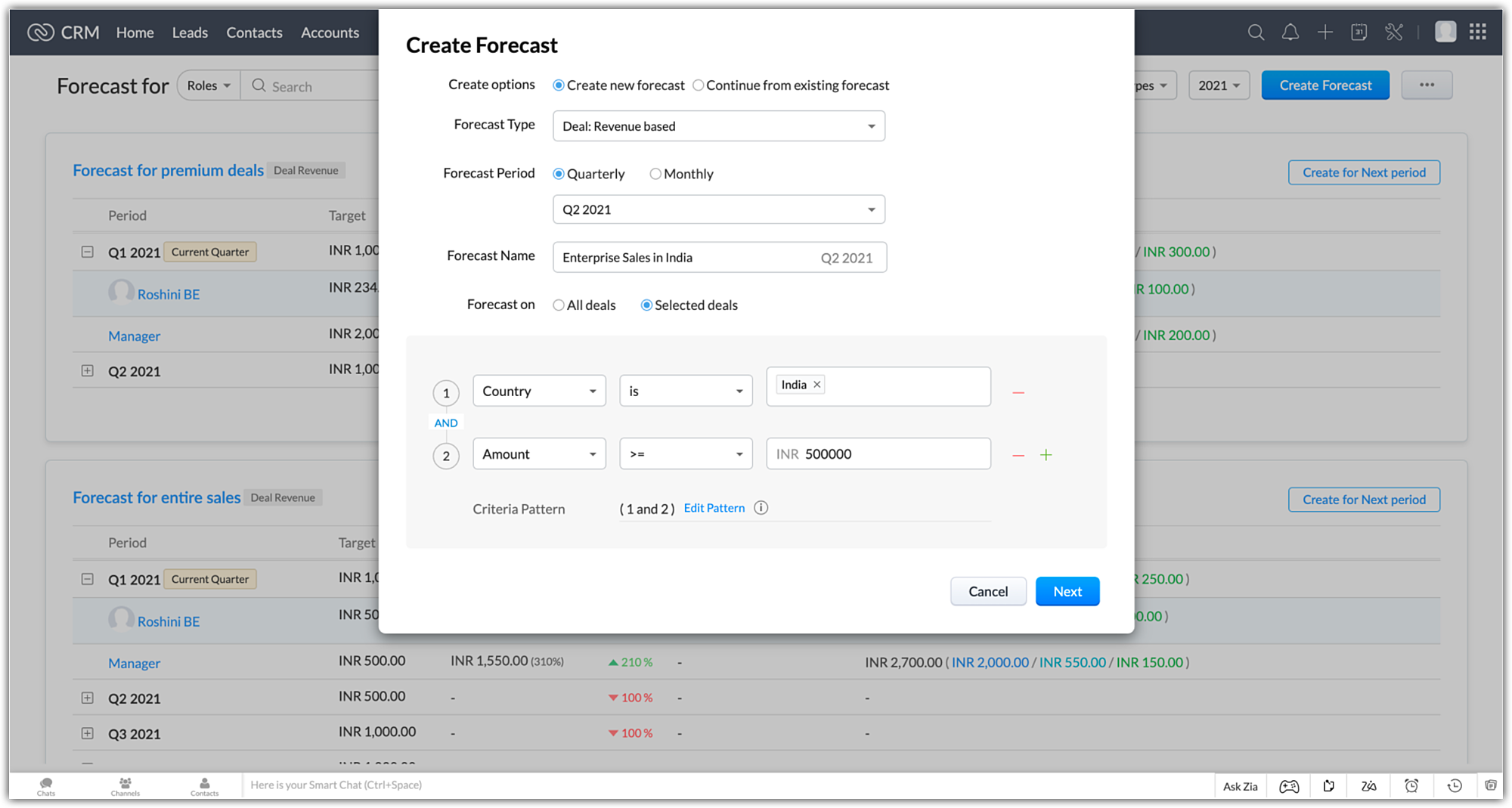
Forecasts can be created monthly or quarterly for the following forecast periods.
- Current - 4 Quarters / 12 months of current fiscal year
- Future - 4 Quarters / 12 months of the next fiscal year
- Completed - The previous 2 fiscal years
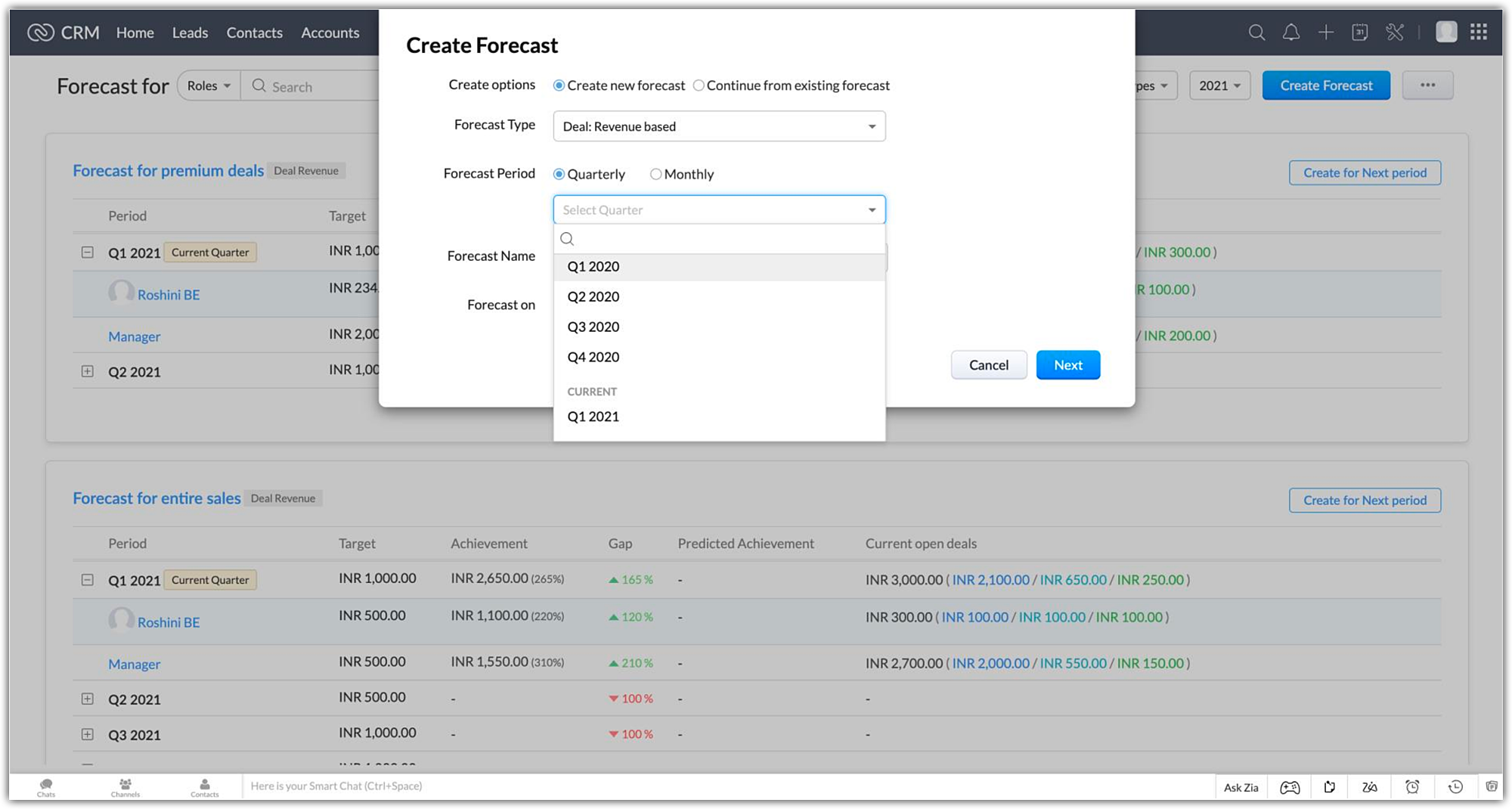
Forecast types
Two forecasts types can be created which are based around the attribute that is used to set targets for your users:
- Deal Revenue based forecasts - These are forecasts where the targets are based on currency fields like deal amount, expected revenue or other custom currency fields defined the deals module
- Deal Quantity based forecasts - These are forecasts where the targets are based on system defined fields like "count of deals" and other custom number fields
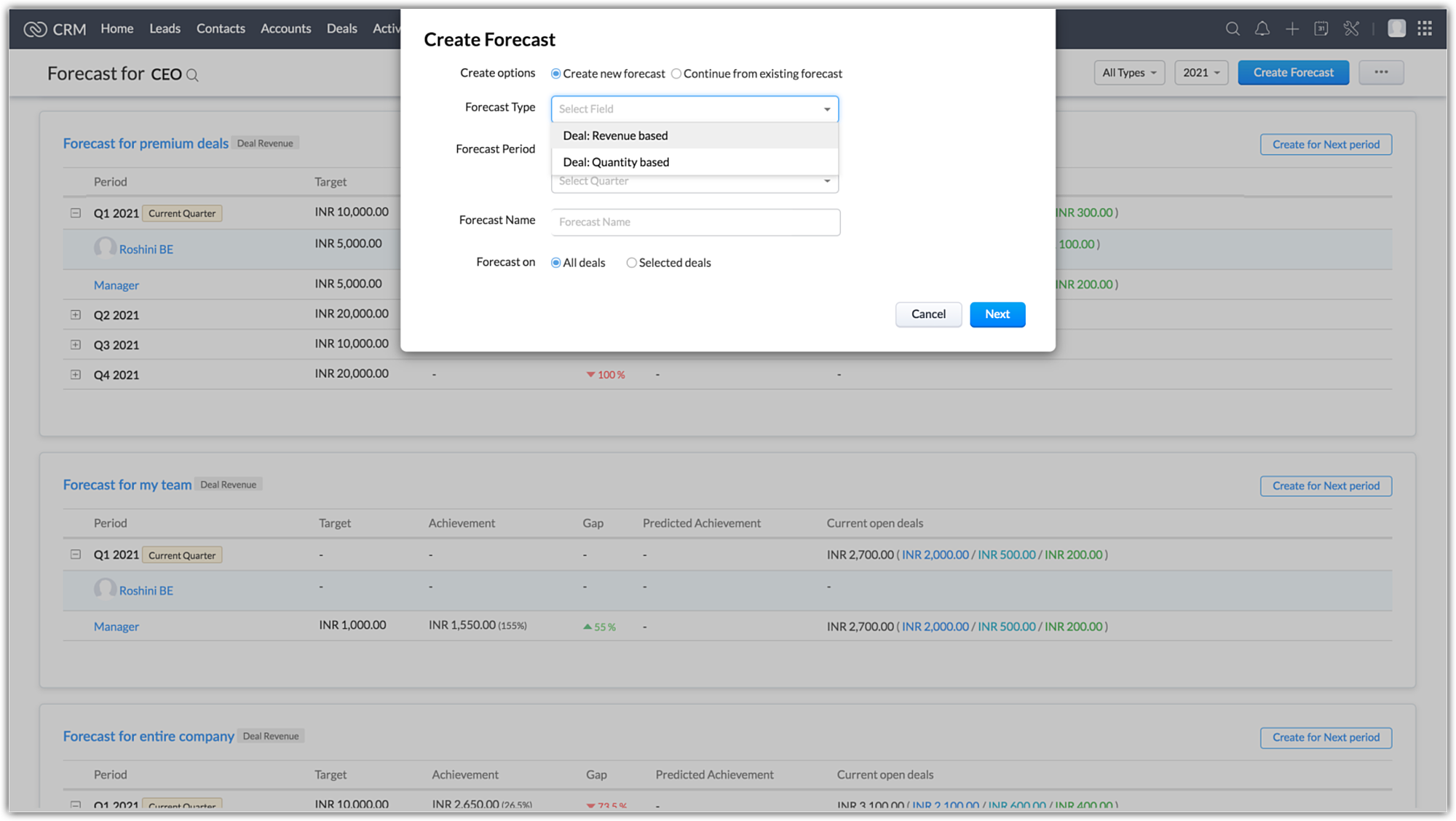
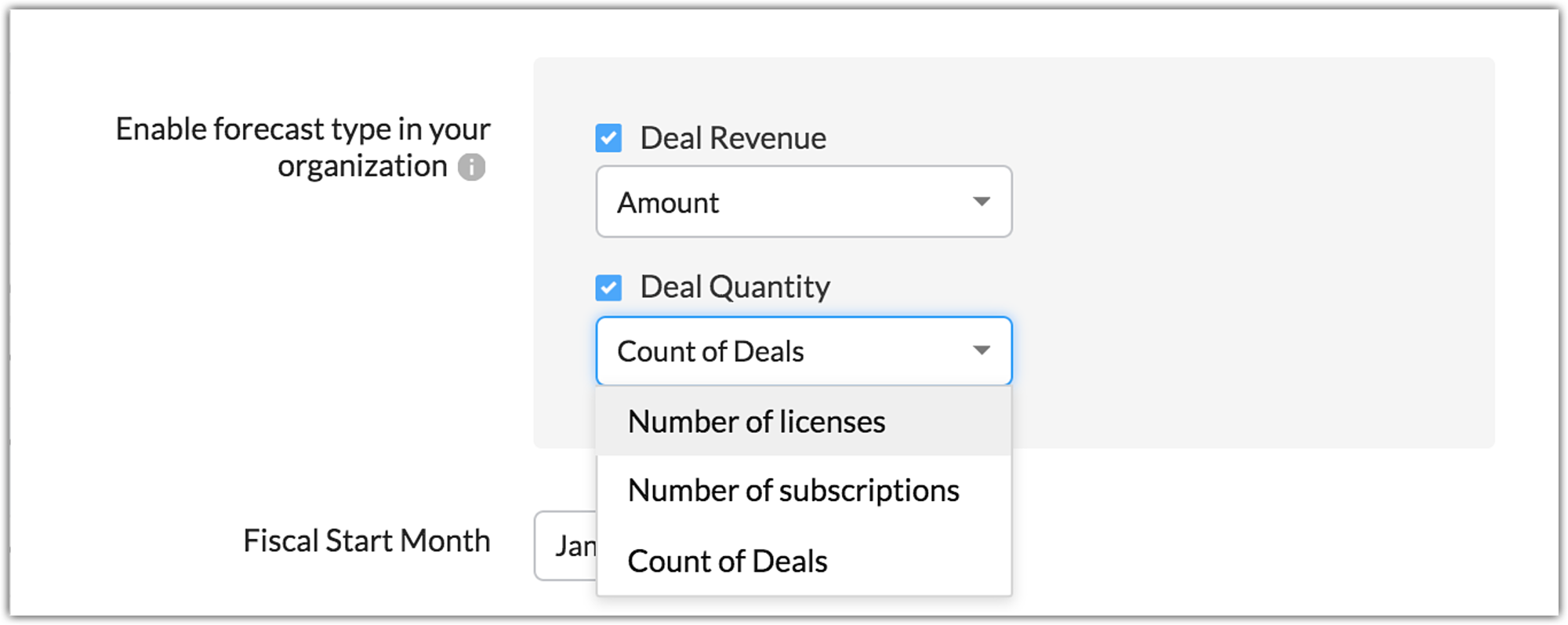
Introducing Best Case and Committed deals under "Forecast Category"
In the current forecasting, deals only had three forecast categories that were associated with them.
- Closed won - Deal was marked "Won"
- Closed lost - Deal was marked "omitted"
- Open - Deal was marked "Pipeline"
Now open deals can be tagged with new options under the forecast category:
- Best case - Open deals that have a high chance of being won
- Committed - Open deals that sales reps commit to winning
Instead of generalising all open deals as pipeline deals, this split gives a better picture as to where a particular sales rep stands in terms of the deals in their pipeline. This allows the administrator to make a more informed decision when setting targets for a particular user.
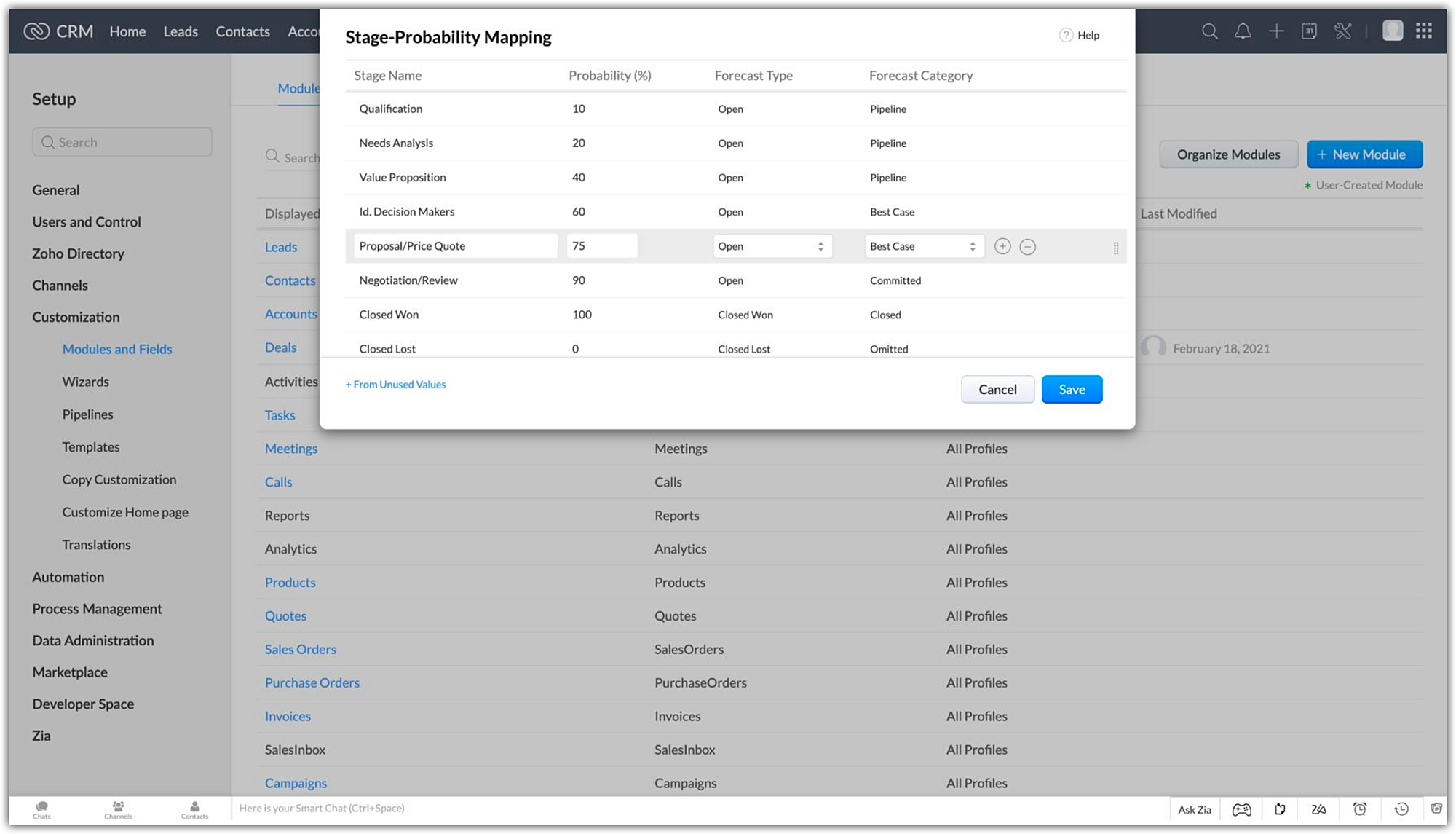
Sales reps also have the option to update the forecast category in a specific deal manually, to the appropriate option when the situation calls for it. The deal amount will then be updated in your forecast during its next sync

Transparent split of deals in your pipeline for optimal targets
When setting targets for your users, a popup with your pipeline data shows the split of deals to give you a better picture of where each user stands in-terms of sales numbers.
The deals are split into open and closed won deals, with the open deals being further split into best cases, committed and pipeline deals.
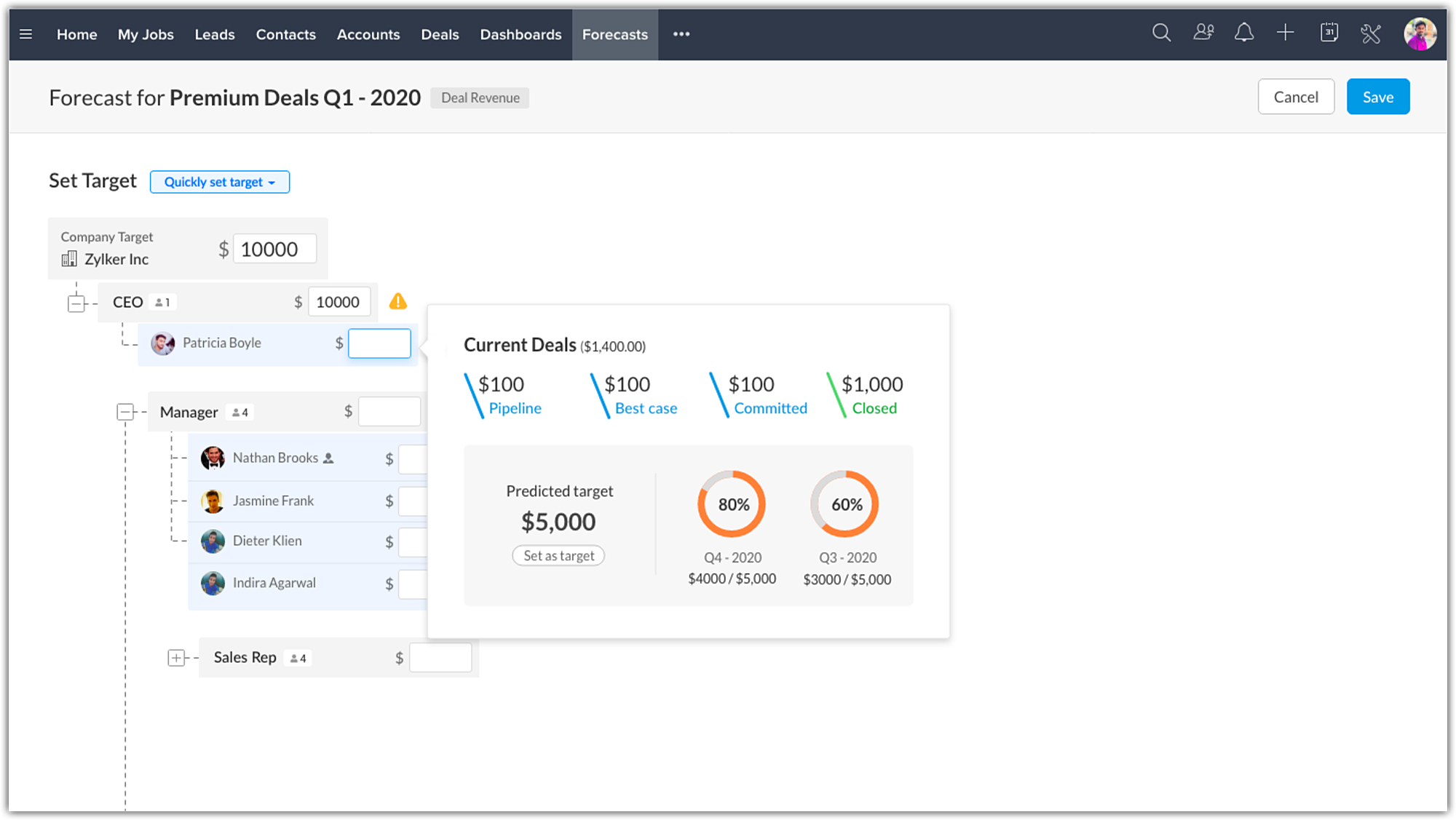
Zia offers target suggestions and predicts target achievement
When creating forecasts, there are two choices. They can be built from the ground up as a completely new forecast, or they can be linked and created from an existing forecast.
When creating a continuous forecast, Zia will calculate and suggest targets based on the historical data of your selected forecasts. This will be available in the forecast create page when setting targets.
The historical and current deal closure pattern of users will be analysed as well to give you the predicted target achievement for the users. Achievement predictions will be available in the target achievement report.
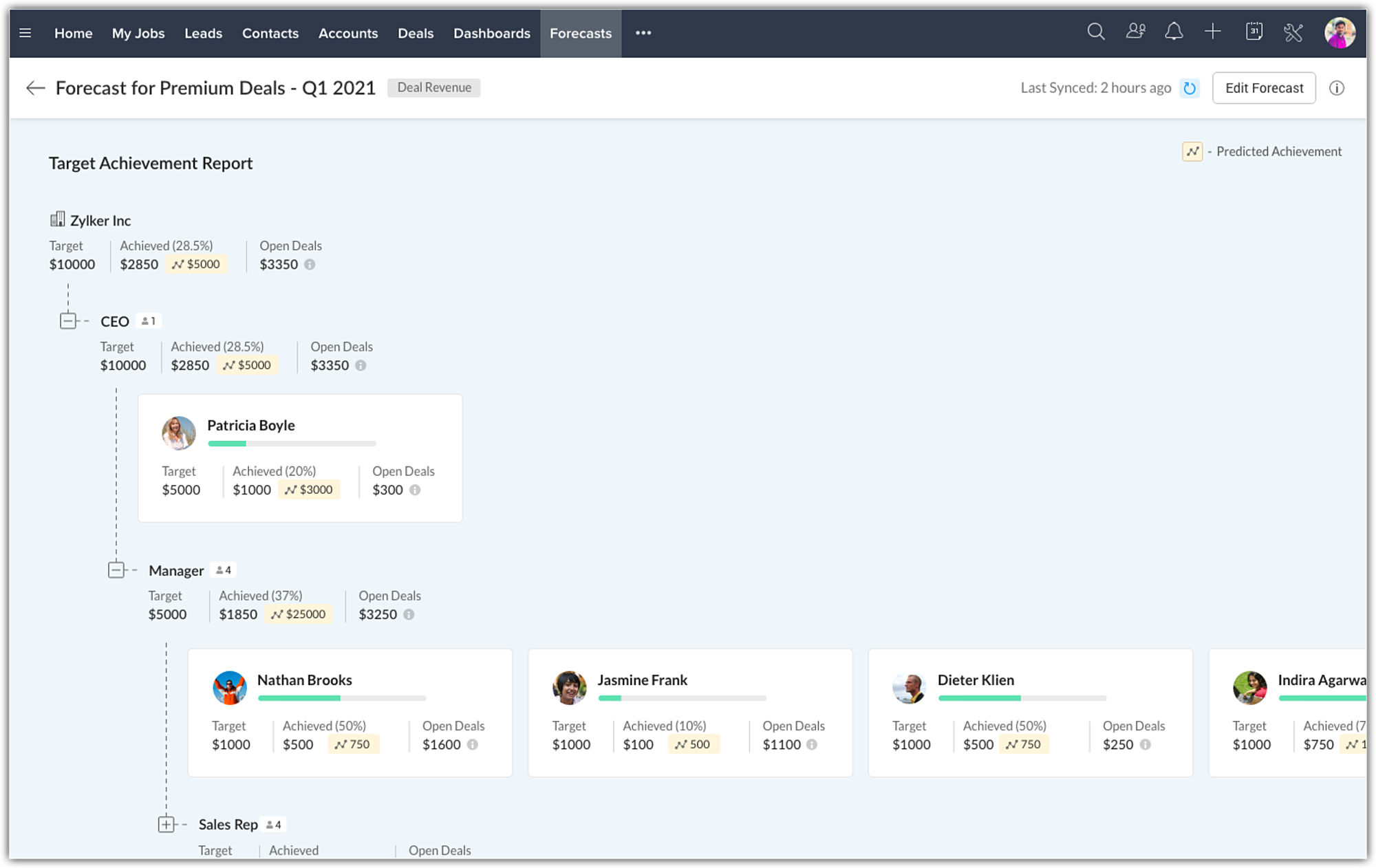
Compare your performance across different forecast periods
All your created forecasts will be available in a list view under the forecast module. You can now drill down into a particular forecast and compare how your business performance fared across the years.
Depending on the duration selected in the filter, the following data will be consolidated and shown at the top :
- Total target
- Achievement
- Gap
Under the consolidated data, the forecast data for each quarter/month for the selected duration will be listed for a bird's eye view analysis. You can then drill down further to analyse the performance of individual users or roles if required.
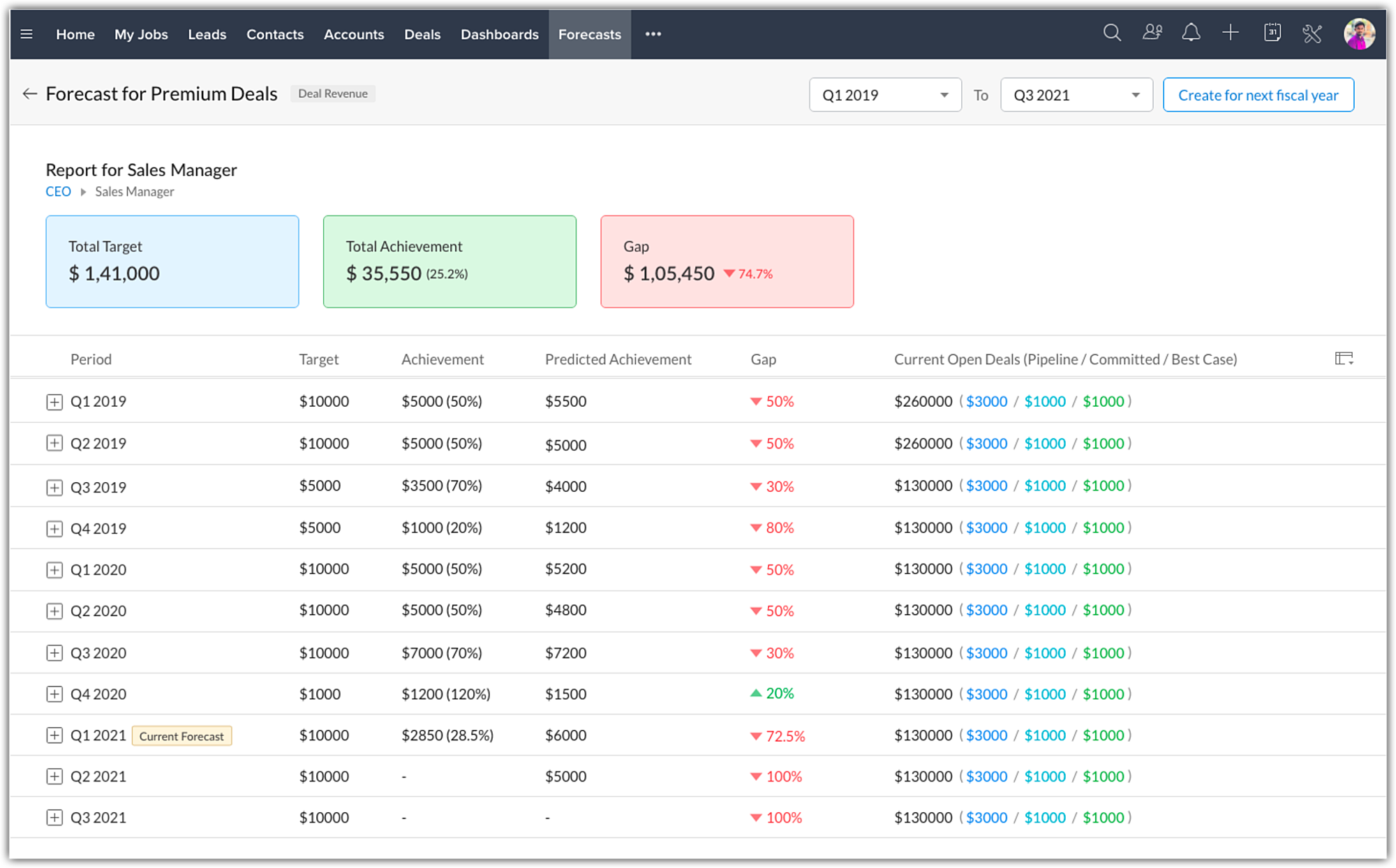
Archived Forecast
The purpose of having forecasts is to keep track of the company's performance on various levels of the organization. Thus far, the forecast list view page shows data only for the completed two years, the current year, and one future year. So, as your business continues, you would be losing forecast records beyond two previous years. This clearly beats the purpose of having forecasts as the past data might still be significantly important. Hence, we have introduced archived forecasts as our latest enhancement.
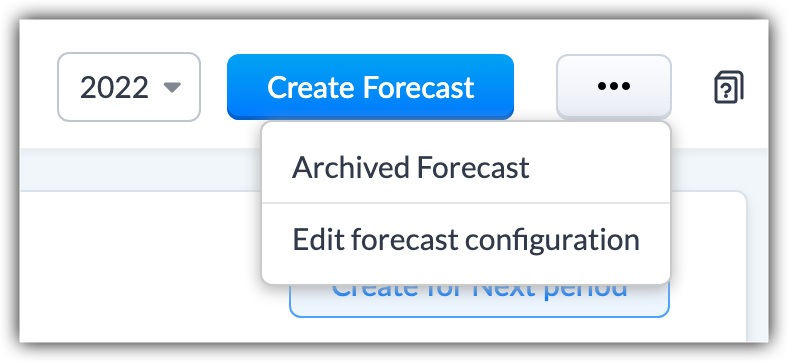
- The forecast list view displays up to 2 completed years' data. Now, the forecasts created beyond these two years will be archived automatically.
For example, suppose the current forecast is for Q3 2021. The list view has records for completed forecasts since Q1 2019. The forecasts before Q1 2019 would be archived. - If a forecast configuration is edited, the current and future forecasts based on old configuration will be deleted while the completed forecasts will be archived.
For the above example of point 1, if you edit the hierarchy or any other configuration, the completed forecasts will be archived, and the current forecast for Q3 2021 will be deleted along with any future forecasts created.
When will forecasts be archived?
- Completed forecasts over two years from the current year will be archived. For example, if the current year is 2022, forecasts of 2021, and 2019 will be available on the forecast list view page. Forecasts older than 2019 will be archived.
- Forecasts will be archived automatically upon editing forecast configuration- changing either the hierarchy or forecast type.
For example if the Hierarchy is Reporting To, and its changed to Territory, or edit the forecast type, the existing forecasts would be archived. - Forecast will be archived if the hierarchy preferences are modified in Company Details.
In the archived forecast page, the forecasts are listed in chronological order. You can also filter them based on Hierarchy, Forecast Type, and Time.
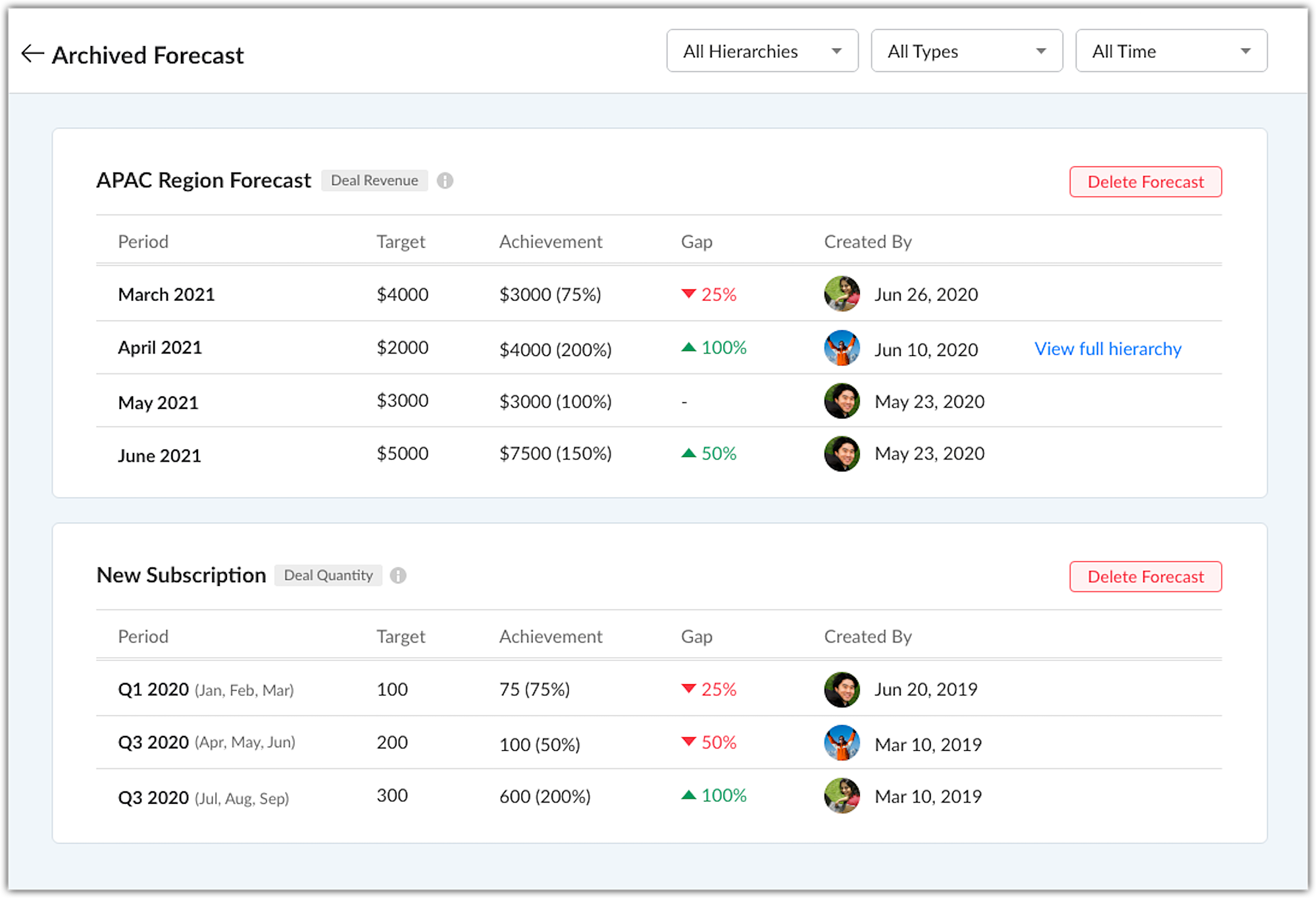
Notes
- The archived forecasts cannot be edited, they are just for viewing purposes. Users can delete a forecast.
- Up to 5 years of forecasts records would be available as archive.
- Changing when the Fiscal Year of your org begins, say changing it from January to April, will delete all the existing forecasts as well as the archived forecasts.
Empowering forecast managers
Forecast managers can now build their own forecasts and assign targets to their role, their own target, their peers and sub roles & users. Individual teams can have their own distinct forecasts and targets which can be focused on. These forecasts will be visible for the Admin, CEO and the forecast manager of a higher role who can monitor these forecasts and update them when needed.
If a forecast manager's target has been modified by the CEO, admin or a forecast manager from a higher role, the modified target is locked and cannot be changed by the forecast manager.
That's all about the enhancements. For more details check out our help page Creating and Working with Forecasts.
We have opened this new forecast for all users subscribed to the paid editions of Zoho CRM, in all DCs. For users who are currently using the old forecasts, they will have the option to switch to new forecast till June end. Post which, it will be mandatory to switch to the new forecasts to access the forecast module.
Looking forward to hearing from you.
New to Zoho Recruit?
Zoho Developer Community
New to Zoho LandingPage?
Zoho LandingPage Resources
New to Bigin?
Topic Participants
Nizamuddin Sohel SK
gavinpereira
Ishwarya SG
Jackie Koehler
Sunderjan Siddharth
Sticky Posts
Presenting ABM for Zoho CRM: Expand and retain your customers with precision
Picture this scenario: You're a growing SaaS company ready to launch a powerful business suite, and are looking to gain traction and momentum. But as a business with a tight budget, you know acquiring new customers is slow, expensive, and often deliversGood news! Calendar in Zoho CRM gets a face lift
Dear Customers, We are delighted to unveil the revamped calendar UI in Zoho CRM. With a complete visual overhaul aligned with CRM for Everyone, the calendar now offers a more intuitive and flexible scheduling experience. What’s new? Distinguish activitiesCreate and populate a record in an instant: Introducing zero-shot field prompting to Zia's ICR
A couple of months ago, we upgraded our in-house AI image detection and validation tool, Zia Vision, with intelligent character recognition (ICR). By training Zia with sample images, you could create and enrich CRM records with data extracted from standardIn-person ZUG Meetups for Real Estate Professionals - US Q1 2026
The Real Estate Zoho User Group is going on a multi-city, in-person meetup tour across the US, and we’d love to see you there! These meetups are a great opportunity to: Connect with fellow real estate professionals using Zoho Share challenges and discoverNimble enhancements to WhatsApp for Business integration in Zoho CRM: Enjoy context and clarity in business messaging
Dear Customers, We hope you're well! WhatsApp for business is a renowned business messaging platform that takes your business closer to your customers; it gives your business the power of personalized outreach. Using the WhatsApp for Business integration
New to Zoho TeamInbox?
Zoho TeamInbox Resources
Zoho CRM Plus Resources
Zoho Books Resources
Zoho Subscriptions Resources
Zoho Projects Resources
Zoho Sprints Resources
Qntrl Resources
Zoho Creator Resources
Zoho CRM Resources
Zoho Show Resources
Get Started. Write Away!
Writer is a powerful online word processor, designed for collaborative work.
Zoho CRM コンテンツ
-
オンラインヘルプ
-
Webセミナー
-
機能活用動画
-
よくある質問
-
Ebook
-
-
Zoho Campaigns
- Zoho サービスのWebセミナー
その他のサービス コンテンツ
Nederlandse Hulpbronnen
ご検討中の方
Recent Topics
What is the difference between Zoho Campaigns and marketing hub?
Zoho Campaigns is a permission-based email marketing tool for sending marketing emails and mass emails. Marketing Automation is a multichannel marketing automation tool that caters to organizations looking for tools to engage their users across multipleWebhook not firing.
I created a webhook using the Web UI, it looks very nice and the testing worked without an issue, but when i save/ update a ticket, the webhook is not firing. Here are the details of the web-hook i get from using the API "modifiedTime": "2019-10-22T09:23:37.380Z",Duplicate customers being created in Desk
Hi I've trying to work out why I've getting duplicated customers being created in my desk. I have an external booking system that generates an email when I get a customer booking a job. A booking email gets sent to Desk where I manage the booking andCreating a custom CSV file using deluge script/
I have an application I have developed and the client wants us to place an export file in csv onto an ftp server daily. Now I don't see au options in creator to change the separator to anything else. The client wants the separator to be the pipe symbol "|" I think i would be able to create schedule with some code to create the appropriate data in a string using deluge script but I haven't seen any functionality that would allow me to deposit that data as a file anywhere or attach it to an emailContact data removes Account data when creating a quote
Hi, Our customer has address fields in their quote layout which should be the address of the Account. They prefill the information, adding the account name - the address data is populated as per what is in the account - great. However when they then addZoho Sheet - Desktop App or Offline
Since Zoho Docs is now available as a desktop app and offline, when is a realistic ETA for Sheet to have the same functionality?I am surprised this was not laucned at the same time as Docs.Can we add custom fields to portal community profiles?
How do we add custom fields to our profile pages in our portal community? If we have the ability to add custom fields, will we be able to access those fields via API? We want to use our Desk community in our help portal as our primary community and wouldCustomer ticket creation via Microsoft Teams
Hi all, I'm looking to see if someone could point me in the right direction. I'd love to make it so my customers/ end users can make tickets, see responses and respond within microsoft teams. As Admin and an Agent i've installed the zoho assist app withinThe Social Wall: November 2025
We’re nearing the end of the year, and the holiday season is officially kicking in! It’s that time when sales peak and your social media game needs to be stronger than ever. We’re back with exciting new updates across AI, analytics, and the mobile appE-Invoicing in Belgium with Zoho Billing
Starting January 1, 2026, Belgium is introducing mandatory electronic invoices (e-invoicing) for all B2B transactions between VAT-registered businesses. Invoices and credits notes must be exchanged in a prescribed digital format. How E-Invoicing worksHTML Tags added to Reports with Notes
Recently Zoho added the ability to markup text within notes. That way, users can change font size, colors, etc. It's a great change. However, since the change, reports that include a column for "Note Content" are printing HTML tags within the report.delayed: host mx2.zoho.com (136.143.183.44): Network error: Unexpectedly disconnected (STARTTLS)
Hi Team, I'm not receiving any email. Seems to be an issue. Sender sent me the error message they received: "delayed: host mx2.zoho.com (136.143.183.44): Network error: Unexpectedly disconnected (STARTTLS)" Please advise.Ask the Experts 26: Brighten every customer interaction with Zoho Desk all year long
Hello everyone, Greetings and welcome to Ask the Experts 26. As we wrap up 2025, we are excited to invite you to the 26th episode of our Ask the Expert series. 🎄The Merry Metrics Edition = Best of Zoho Desk [Best Practices + Holiday Automation + Year-EndInterview booked through Invite but no Notifications
We have a workflow that was developed through a developer/partner that was tested and worked. Today, we pushed a candidate through the process and invited them to an in-office interview. They were sent the booking link (as usual and as tested before successfully)Additional Address - Company Name
It would be very helpful to have a "Company Name" field in the Additional Address shipping section. In a situation where you drop-ship orders to a different address or different company entirely, it may be necessary to list the company name of the receiver. I understand that the Attention field can be used for that purpose, but that's not really the intended purpose of that field.Incorrect Email Notifications for Product Reviews
Dear Zoho Commerce Support Team, I am writing to report a technical issue that occurs frequently on our platform. Problem Description: We regularly receive email notifications informing us of new product reviews awaiting approval. However, when we accessAuto-Invite Users to Portals in Zoho CRM based on Conditions
Hello Everyone, You can now automate portal invitations in Zoho CRM with the new Auto-Invite users feature in Portal management. No more manually enabling portal access one by one. With this enhancement, you can automatically send invites for users toIn App Auto Refresh/Update Features
Hi, I am trying to use Zoho Creator for Restaurant management. While using the android apps, I reliased the apps would not auto refresh if there is new entries i.e new kitchen order ticket (KOT) from other users. The apps does received notification but would not auto refresh, users required to refresh the apps manually in order to see the new KOT in the apps. I am wondering why this features is not implemented? Or is this feature being considered to be implemented in the future? With theHow to Rank Tables by Row Count in Descending Order
I am trying to understand the consume of lines that grow up so fast in the last week. Is there any way to create a pivot table or query to get TABLE NAME LINES in descending order?Error AS101 when adding new email alias
Hi, I am trying to add apple@(mydomain).com The error AS101 is shown while I try to add the alias.Can we do Image swatches for color variants?
We want to do something like the attached screenshot on our new zoho store. We need image swatches instead of normal text selection. We want to user to select an image as color option. Is this doable? I don't see any option on zoho backend. Please hExport your notes from Notebook!
Dear users, The long awaited feature is now live. Yes, you can now export your notes from Notebook app in bulk. But the feature has just started with web app alone for now. You can try the export feature as mentioned below: Go to our web app, https://notebook.zoho.com Go to 'Settings' > 'Export' Now, select the format: You can select either ZNote or HTML Once done, you can use the same to import or can have this a local backup of your notes. Note: Export for other platforms are in development andCanva Integration
Hello! As many marketing departments are streamlining their teams, many have begun utilizing Canva for all design mockups and approvals prior to its integration into Marketing automation software. While Zoho Social has this integration already accomplished,Prepopulating Fields
Hello, I have a form (Assets) with 2 lookup fields: Client (from Clients) Site (from Client Sites) I modified the code (highlighted in red below), so the Site dropdown shows the list of sites related to the Client. must have Client_Site ( type = picklistCRM x WorkDrive: File storage for new CRM signups is now powered by WorkDrive
Availability Editions: All DCs: All Release plan: Released for new signups in all DCs. It will be enabled for existing users in a phased manner in the upcoming months. Help documentation: Documents in Zoho CRM Manage folders in Documents tab Manage filesSync Zoho Marketing Automation with Zoho Forms
I can't find a section where the integration between Zoho Marketing Automation and Zoho form is explained. And how form subscription works with opt-in and consents.REPORT THAT SHOWS SOH FOR ITEMS THAT HAVE ZERO SALES
When we started Zoho we imported a lot of inventory lines directly off our suppliers price list and have never ordered / sold. I want to clean up our data base and remove all these lines. What reeport will show me what lines have zero sales as well asAutomation series : Close all tasks once the project is completed
When a project is marked as Completed, it might still have open tasks such as recurring tasks that were not marked as complete, tasks that are no longer relevant, or tasks that no longer need attention after closure. To ensure the project reflects itsConverting Sales Order to Purchase Order
Hi All, Firstly, this code works to convert a sales order(SO) to a purchase order (PO) via a button, however I am running into an issue when I convert the SO where the values from the line items are not pulled across from the SO to the PO. The ones inAll new Address Field in Zoho CRM: maintain structured and accurate address inputs
The address field will be available exclusively for IN DC users. We'll keep you updated on the DC-specific rollout soon. It's currently available for all new sign-ups and for existing Zoho CRM orgs which are in the Professional edition. Latest updateHorrible Connectivity!
I have used Meetings several times, but most of the time the connection is horrible. The video freezes, the audio freezes, and we end up cancelling the meeting. I am on a high speed internet connection, and Zoom works fine, so I know it's not a problemIs it really true that I can't set the default 'deposit to' account in 2025?
I've been using Books for 7 years and the default account has never been a problem. I usually manually reconcile invoices and have never had a thought about which account. It has always been my account. However, I recently noticed that for the past 4Zoho DataPrep switching Date Format
When using a pipeline that is importing Zoho Analytics data into Zoho DataPrep, the month and day of date fields are switched for some columns. For example, a Zoho Analytics record of "Nov. 8, 2025" will appear in Zoho DataPrep as "2025/08/11" in "yyyy/MM/dd"Using Another Field Value for Workflow Field Update
I'm trying to setup a Workflow with a "Field Update" action on the Lead module, but I would like the new value to actually be taken from a DIFFERENT Field's on the Lead record (vs just defining some static value..) Is this possible? Could I simply useGreek character in Deluxe script
Hi, We have been using a script since 2022 which replaces characters in Greek contact names using replaceAll. Since this morning, all the Greek characters used in the script have turned to question marks. I tried retyping the characters, copy-pastingTax information
Hello, I need help/guidance on how to add my organization's Tax/VAT information. Thank you PavlyBuild smarter Guided Conversations with Fork Blocks
When your customers arrive on your support channel, they're not there to explore. They are usually confused and stuck while trying to fix something important. We understand how stressful that moment can feel and we want your bot to make things easier,Custom item field won't allow decimal.
Hello, I have a custom item field that needs to be able to have a value with a decimal place such as 6.7 or 6.18. I have tried custom formatting the input format but can not get the correct syntax to allow this. Is this possible in Zoho?Free webinar: Zoho Sign unwrapped – 2025 in review
Hey there! 2025 is coming to an end, and this year has been all about AI. Join our exclusive year-end webinar, where we'll walk you through the features that went live in 2025, provide answers to your questions, and give you a sneak peek on what to expectHubSpot CRM to Zoho Creator Integration
I'm trying to create an integration between HubSpot CRM and Zoho Creator with HubSpot being the push source (if a contact is created or updated in HubSpot, it pushes the information to Zoho Creator). I have two questions: 1- Is it best to use Zoho FlowNext Page












